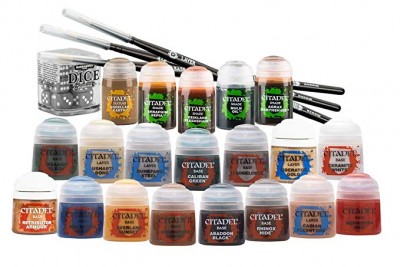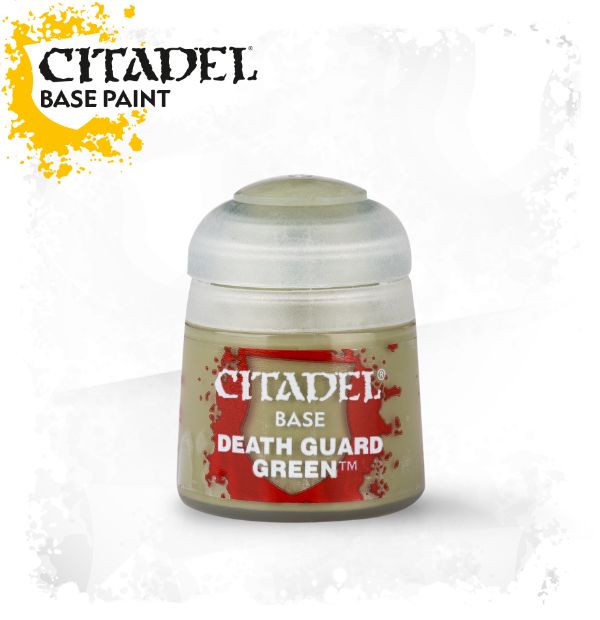This will be a series of articles on how to improve your paint, next we have GW Paints. Edwin Moriarty is a commission painter and games developer living in Nottingham, UK. Keep up with his latest projects on Instagram.
Paint! Glorious Paint! There’s nothing quite like it for creating “objects of magic and wonder” (thanks GW circa 2014).
If you’re used to any other brands of miniature paints, Citadel paints are a little bit strange. They have several different types, and it’s unclear on first glance what the distinctions are and why they exist. Enter me, happy to help!

There are at current the following 10 types of paint in the CPS:
- Layer
- Air
- Base
- Dry
- Shade
- Texture
- Spray
- Technical
- Edge
- Glaze
In this article we’re going to leave aside texture and technical paints, and look just at the eight remaining types.
Let’s talk about those GW Paints
Before we go further we need to rock some knowledge about paint. What we call paint is acrylic paint – pigment (in the form of a powder) suspending in a medium made of acrylic (plastic). The pigments are made of all kinds of cool stuff (there’s a whole world of information about pigments out there, check em out), but the medium is specifically acrylic. Most of the paint we use would be referred to as fluid acrylics or soft body acrylics – paint that has a flow to it. It retains a high pigment density. Generally when we consider paint we need to consider three key properties:
Viscosity is how thick the paint is, Pigment Density is how vibrant the colour is and how opaque the paint is, and Flow or Surface Tension which is a measure of how well the paint adheres to a surface and how likely it is to bead. Though all of these properties are connected, they can be altered separately with care.
One of the key things to know about pigments is the difference between paints of different colours due to different pigments and paints of different hues. Paints that are different colours due to pigments are made from distinct materials in the pigment. A cobalt blue and a midnight blue in traditional artist’s acrylics, for example, are made from different pigments. Hues are colours of paint that are created by blending multiple pigments together to achieve a blending colour.
Like most miniature paints, the majority of citadel paints are hues. That’s fine, but it means they tend to split if you’re not careful (just leave some thinned fenris grey on a wet palette overnight and you’ll see what I mean).
Layer paints

Layer paints are pretty close to what other companies put out as their standard formulations, but they have some differences. They’re medium viscosity, medium pigment density and low-medium flow paints. They’re slightly transparent, meaning that they can be used to build up layers of colour. You can achieve a smoother effect when highlighting in less layers. They generally stick when you put them, not flowing into recesses.
The vast majority of layer paints should be thinned with water. You can thin metallic layer paints with water, but you’ll likely find that thinning it with lahmian medium is more effective.
Air paints
Air paints are, unsurprisingly, those that are formulated for air brushes. The colours available span both base and layer paint hues. They’re low-medium viscosity, medium-high pigment density and medium flow paints. If you want to buy paints from Games Workshop and avoid the CPS entirely, I’d generally recommend buying air paints – they’re remarkably similar to what other companies sell, with the added advantage you can put them straight in an airbrush if that’s your thing. Air paints sit a little awkwardly outside the rest of the CPS, as air brushes are not really considered to be a common or accessible technique, and few of the tutorials or resources are positioned to make use of them, if any. These air paints are not a thing you’re likely to buy unless you have an airbrush, or have specific needs.
Air paints should be thinned with airbrush thinner and flow improver where possible. In a pinch, lahmian will do the job.
Base paints

Base paints are one of the best aspects of the Citadel Paint System in my opinion, and service a niche that other companies don’t fill. They’re medium viscosity, high pigment density, low-medium flow paints. Their pigment density is extreme, and the intention of that is so that you can get strong, vibrant base coats on your miniatures in one or two coats (two thin coats is the Duncan way, but with some colours you can get away with one for sure). This makes them an invaluable tool for quickly blocking in colour. The downside is that they are very opaque, and so will create start strong distinctions when highlighting, and are poor for layering.
Just like layer GW Paints the majority of base paints should be thinned with water, but metallics can benefit from lahmian.
Dry paints
Dry paints are an answer to a very obvious question: “when I dry-brush, aren’t I leaving a hell of a lot of paint on the tissue for no good reason?”
The answer, it turns out, is yes. Dry paints are, obviously, dry. They’re very high viscosity, high pigment density, very low flow paints that are intended exclusively for dry-brushing. Slap your dry-brush in the point, few quick wipes on kitchen towel, and you’re good to go.
Generally, you don’t want to thin dry paints. However, there are some neat tips and tricks for using them in unconventional ways I’ll cover in a future article.
Shade paints

Shade paints, or shades, are one of the key parts of the Citadel Paint System arsenal. The epithet “liquid talent” is perhaps not 100% accurate, but it’s damn close. Unlike previous incarnations of the CPS where inks featured heavily, the current version uses very low viscosity, low pigment density, very high flow paints as their shades. This means that they’re watering, and when you slap them on they’ll flow into the recesses of the miniature. This lets you quickly shade (aha) it.
Sometimes you do want to thin shade paints, but not always. When you do, you generally should thin with lahmian medium, as that is formulated specifically for this task.
Edge paints
Edge paints are probably one of the least essential parts of the CPS, but equally they’re not worthless – they’re just more hues of layer paint that trend towards the very light and bright colours. Just like layer paints they’re medium viscosity, medium pigment density and low-medium flow paints, with hues designed to compliment common sets of base and layer paints for extreme edge highlighting.
Just like layer paints, you should thin these with water.
Glaze paints
Glazes paints are very small range at the moment, but are an interesting complement to the other options. Just as you might expect, they are low viscosity, low pigment density, medium flow paints. When you paint them on they’ll tint the colour showing underneath, more or less stay where you put them (and not flow into recesses like shades), and operate generally like layer paints otherwise. They’re a little less viscous than layer paints, and broadly you shouldn’t need to thin them.
Spray paints
These are a different beast to the rest of what we’ve talked about. Spray paints come in a spray can, and are aerosolised so that they can be applied thinly in even coats without an airbrush. They also contain acetone, which means that the paint can bite into the material of the miniature a little better by fusing the pigment to the surface. This means that when additional coats go on, they have something better to stick to than the very smooth plastic. Yes, that means they’re primers. Yes, all of citadel’s sprayers are primers, regardless of what the internet says. They prime the surface, making it ready to paint on, that makes them a primer.
There are two distinct “types” of spray in the range: the classic primers (chaos black and corax white) and the colour sprays. 99% of the time there’s not difference – on plastic or resin either spray will do fine. Some of the colours you’ll struggle to get strong even coats without doing multiple thin layers or first using one of the classic primers then using the other on top. That’s nothing to do with their ability to prime plastic or resin, but to do with their pigment mix, which isn’t a smooth (Mephiston Red is particularly bad).

However, there is an exception: metal miniatures. If you’re painting metal miniature, you should always use a classic primer. The acetone content is higher, and you’ll find it has better results.
One thing to note about the range is that while the colour sprays are genuinely a good match for the base paint of the same name (and use the same pigments, which is why the results can sometimes be a little wobbly depending on how they’ve taken to the aerosol format), the classic primers are not. Chaos black and Abaddon Black
are not the same, and Corvax White doesn’t match any white GW sell as a base paint. If you use one of these and intend to use a black or white base coat, you’ll need to brush or air base coat the miniature with an appropriate paint.
In the next instalment: brushes!
-Edwin
You can see some of Edwin’s work on previous Dreadtobers and his Morty’s Minis Instagram account.

Nice overview! A few additional bits from my own experience/preferences.
– The Base paints are absolutely the best aspect of the line here. For stuff like reds, yellows, and golds, they’ve taken away so much of the aggravation and hassle that used to be a necessary part of working with those colours.
– The next step up, however, hits the single biggest issue I have with the CPS: The paints they recommend for highlighting, particularly in the Dry and Edge lines, and on the green/blue/purple half of the colour wheel, are almost universally paler/lighter shades, rather than brighter ones. That doesn’t lead to results that look like what you get when actual coloured objects are lit.
– I’m also not a huge fan of the Shade line. They’re not terrible, but they can have issues with inconsistencies in their finish, and occasionally end up with a chalky white appearance in what should be the darkest parts. I almost exclusively use Army Painter shades any more.
– I still haven’t got around to trying the Glazes. Need to get on that, as they seem like they could be quite useful. I do wish they had a purple, tho.
– I have heard that Ulthuan grey is the match for Corax white. No personal experience with it myself, since I don’t use GW sprays, but I’ve seen some stuff done that way that looked pretty good to me.
Thanks for sharing this, and I look forward to the remaining installments!
Hello Westrider, thanks for your comment!
I absolutely agree that the base paints are the best part of the line. They’re really something unique.
You’re right, and it’s an issue with some elements of the system, but it does depend on your style. The cartoony style the CPS encourages fits the paler shades better, but I agree that some variation would be a strong improvement.
I’ve had good experiences with Army Painter Shades, but I do have a lot of love for the GW ones. I fine that the chalkiness you describe is often the case when the paint hasn’t been shaken thoroughly as they are a little prone to settling. I’ve also experienced glossiness as an effect of this – both of which can be solved by thoroughly agitating the paint before use.
I really wish the glaze range was more extensive! I’ve asked several times that they consider it, but no sign to date!
Ulthuan is pretty close but it’s not the colour specifically that’s different, it’s the finish. Getting that finish will still require you to base with Ulthuan over the top.
Thanks again for your comment, and I hope you enjoy the articles to come!
Yeah, it is that I’m not really a fan of the style that tends to result from those highlights. I don’t really care for GW’s emphasis on edge highlights everywhere, either.
I know the issue with the Shades can be avoided, but I’d rather just us AP and not worry about it. I also feel like the pigment density and flow are a bit closer to what I want in the AP Shades than the Citadel ones.
Ah, that would explain it. The examples I’d seen, there were later steps that involved running washes and/or glazes over the entire Mini, which would cover up the difference in finish.
Oh the rants I could go on about GW’s edge highlights…
I might well be able to match them 😉
Mix Lahmian Medium + anything (purple wash, purple paint, etc.) at a 1/1 ratio and you’ve got a glaze. I do this all the time with the purple wash to create a purple glaze; works great.
I’ve tried that on a number of occasions (usually after each time you do a tutorial), and I’ve never managed to get it to work. It always either turns into a wash or comes out horribly splotchy.
It is easier with washes, making them a glaze that is. With paints you tend to have to add a bit more medium, depending on the color, maybe at a 2 to 1 ratio of medium to paint.